Finding an Ecological Niche: A Three-Part Series on Selected Foothill Woodland and Chaparral Species, Part 2 of 3: The Gray Pine
By Laura Lukes, UC Master Gardener of Butte County, March 8, 2019
[Note: Gray pine (Pinus sabiniana), buckeye (Aesculus californica), and blue oak (Quercus douglasii) are tree species that thrive in rugged local foothill woodland and chaparral habitat. Last edition, we covered the blue oak, and today the gray pine is featured. The final installment will explore the buckeye. All three species rely on adaptive strategies evolved over time allowing them to thrive in their challenging environment.]
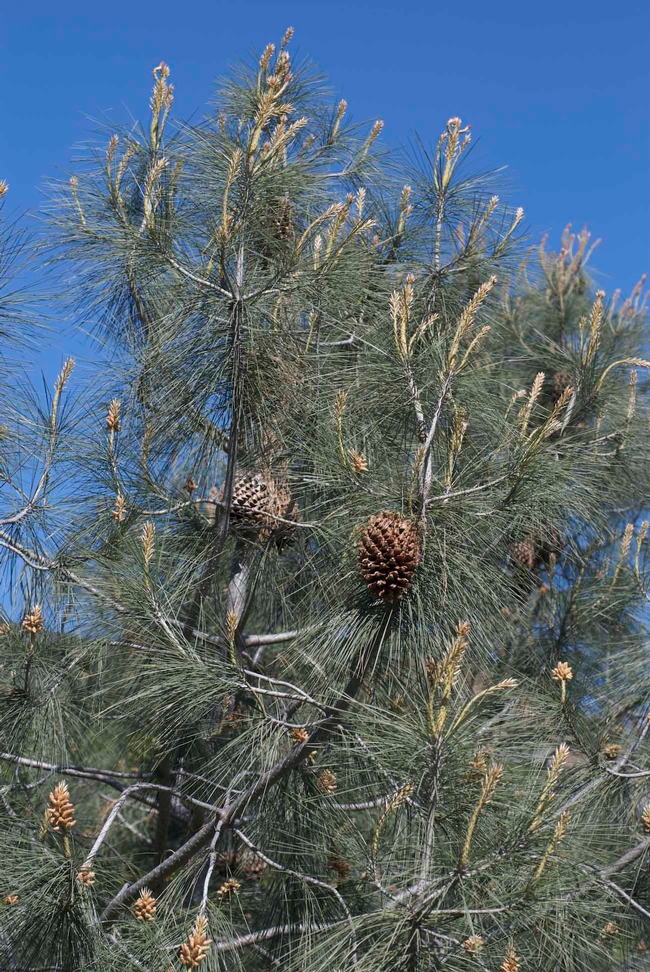
But underneath that homely exterior lies a true gem. This tree's many common names testify to its importance: gray pine, California foothill pine, foothill pine, nut pine, bull pine, and ghost pine. Its pejorative historic name, digger pine, is no longer in use. The Maidu named it “towáni” and the Yana called it “c'ala'I.” Its scientific name derives from the English lawyer, naturalist, and writer on horticulture Joseph Sabine (1770 to 1837). Sabine had a lifelong interest in natural history and was an original fellow of the Linnean Society. It was Sabine who was responsible for sending David Douglas on specimen collecting trips, specifically to supply plants to the Royal Horticultural Society Gardens.
We are not certain of the lifespan of the gray pine, because older specimens were cut down by early settlers, but it is believed that these trees can live for over 200 years. When mature, they average from 40 to 80 feet tall. About 15 to 25 feet off the ground, gray pines develop two or more twisted stems that can grow at irregular angles to one another, resulting in a crown that appears open and ragged. Gray pine is self-pruning, and the remaining lowest branches will end up high above the understory. Where soils allow, gray pines can develop a deep taproot, but in hardpan soils their roots are spreading and shallow, and the bark thickens as the tree ages.
The female cones are the largest and heaviest in the entire pine family. They could be mistaken for a football lying amongst shed needles, as they can be up to one foot long, and when dry are dull orange/brown. A green cone can weigh over two pounds. That, and their sharp spines, warn one to be alert while treading under this tree!
Like the blue oak, a common co-habitant, the gray pine is endemic to the California Sierra Nevada and Coast Range foothills. The two trees are so often found together that "oak/foothill pine vegetation" or "oak/gray pine vegetation" describes a type of habitat characteristic of the chaparral and woodlands ecoregion in California. Gray pines even surpass blue oaks in their ability to tolerate harsh conditions: they are found in the Transverse and Peninsular Ranges, and the Mojave Desert sky islands. They can handle from as little as 10 inches of rain per year to an annual 70 inches in parts of the Sierra Nevada. While these pines prefer rocky, well-drained soil, they will grow in notoriously poor serpentine soils and heavy, poorly drained clay soils. Their ability to withstand extreme soils comes from a special adaptive strategy: they are able to regulate uptake of soil nutrients as needed.
Surviving Drought and Fire
In an evolutionary adaptation to the dry hot summers of a Mediterranean climate, the gray pine has thin, gray needles up to 12 inches long that help it deflect heat and retain water. Surprisingly, this species is not fire resistant. On the contrary, it is highly flammable: its needles contain ether extracts; its wood, bark, cones, and needle sheaths all contain pitch; and its trunk often is coated with resin that has dripped from wounds. Its fire survival strategy lies in two specific adaptations. First, large trees will better survive moderate-severity fires because the thickened bark of mature trees and the self-pruned trunks with high branching limbs are best able to avoid fatal scorching. Second, seed regeneration is actually favored post-fire. As noted by the USDA, fire creates a receptive “bare mineral soil seedbed, and heat scarification of the woody seed coat increases germination rates.”
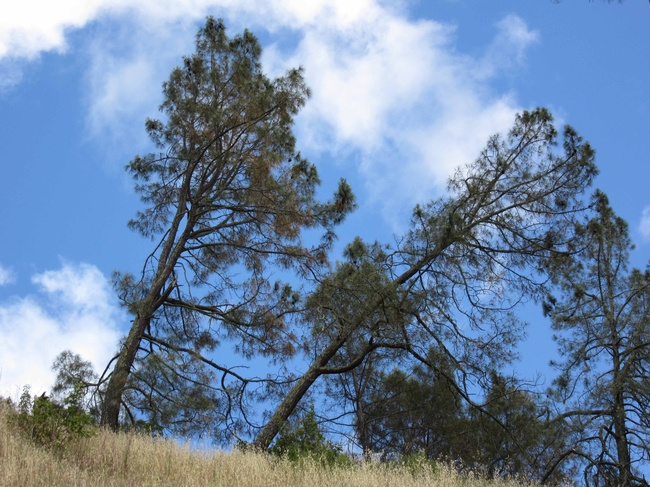
For California's native peoples, the gray pine was (and still is) a nutritional jackpot! Pine nuts are densely caloric, loaded with protein, easy to harvest, and store well for long periods. While many of California's pines provided food to native populations, the nuts of the gray pine were the most highly valued. They could be eaten raw, parched in baskets, and steamed in earth ovens. They were pounded into flour that was made into butter, soup, or bread; mixed with meal made from other dried seeds; and combined with dried salmon. In spring, green cones were roasted to yield a syrupy treat.
Every part of the pine tree had a use. Deadfall was used for firewood; needles served as tinder or were fashioned into torches and were also burned as a smudge for spider bites. Fresh, frangrant needles were spread on the floor of earth lodges. Supple branches were used as stirring sticks and to lift hot rocks from fires. Pine roots were used in basketry and the pine's abundant resin was used for medicinal purposes. Traditionally this species provided vital resources to native peoples. One can only imagine how horrifying it must have been for the tribes that relied so heavily on this tree, to see most of the old growth pines “harvested” during the Gold Rush era to fuel the engines at quartz mines.
Crooked, ragged, and awkward as the gray pine may appear, its ability to thrive under environmental hardship, and its value to native peoples' survival make it an ecological and cultural champion. After all, handsome is as handsome does.
For sources and further information, see the following:
M. Kat Anderson, Tending the Wild: Native American Knowledge and the Management of California's Natural Resources (University of California Press, 2005).
Laura Brodhead, “Native Plant Society: An appreciation of the gray pine,” Redding Record Searchlight, February 4, 2017:
Conifer Society: http://conifersociety.org/conifers/conifer/pinus/sabiniana/
USDA: https://www.fs.fed.us/database/feis/plants/tree/pinsab/all.html
Trees of Stanford: https://trees.stanford.edu/ENCYC/PINsab.htm
For more information on gardening in our area, visit the Butte County Master Gardener web page at: http://ucanr.edu/sites/bcmg/. If you have a gardening question or problem, call our Hotline at (530) 538-7201.
Photo credits:
Pine against the sky: http://www.treebuzz.com/forum/media/mature-digger-pine-trees-pinus-sabiniana.509/
Needles and cones: : https://commons.wikimedia.org/wiki/File:Pinus_sabiniana.jpg
Rising From the Ashes, March 8, 2019
The UC Master Gardeners of Butte County are taking note of vegetation re-emerging on property destroyed by the Camp Fire. Robert DiPietro reports that while the fire destroyed everything on his Lower Pentz Road property between Stearns and Country Club, he is now seeinggarlic, red onions, artichokes, day lilies, primrose, columbine, and bluebells appearing, along with all of the grasses and some succulents and cacti. Fay Crociani has a daffodil blooming on her Upper Paradise lot – its leaves and stem are shorter than usual, but the color is beautiful, and she says tulips and naked ladies (amaryllis belladonna) have also survived the fire, while stachys (7-up plant), ceanothus (mountain lilac), penstemon and aastache have put up identifiable shoots. She, too, says some of her succulents are showing signs of life. “Snooping around my neighborhood,” Fay reports, “I saw a badly damaged camellia blooming its heart out and a rhododendron with hundreds of new strong leaf buds. Mother Nature strong!!!”
Finding an Ecological Niche: Selected Foothill Woodland and Chaparral Species, Part 1 of 3: The Blue Oak
By Laura Lukes, UC Master Gardener of Butte County, February 22, 2019
[Note: Blue oak (Quercus douglasii), gray pine (Pinus sabiniana), and buckeye (Aesculus californica) are three species that thrive in rugged local foothill woodland and chaparral habitat. Today and in the following weeks, this series will look at these species and the adaptive strategies they have evolved over time to thrive in their challenging environment.]
What drives the evolutionary journey of the flora and fauna that populate our globe?

Some species cooperate by sharing resources. For example, in Tortuguero, a tiny strip of beach along the northeastern shoulder of Costa Rica, four separate species of sea turtle lay their eggs each year. They migrate to the beach at different times, ranging from early March to October, and feed on different resources. Millions of turtles, and untold numbers of their babies, have shared the same tiny piece of real estate for eons.
Here in our own backyard, there are species that have evolved to exploit ecological niches that very few others claim. These are the various oaks, conifers, and woody shrubs that populate the foothill woodland and chaparral zone of the Western Sierra Nevada and Coast Range mountains. A dominant species in this environmental nook is the blue oak (Quercus douglasii). According to Andrew Conlin, Soil Scientist with the Natural Resources Conservation Service (NRCS), “the presence of blue oak woodlands indicates really rough growing conditions: shallow, tough soils” as opposed to the rich loamy soils of the valley, which are preferred by valley oaks.
Quercus douglasii also goes by a number of other common names, including white oak, mountain oak, mountain white oak, and iron oak. But it acquired its most familiar and descriptive common name from the same person from whom its Latin binomial (scientific name) is derived. In 1831 David Douglas, a Scottish botanist, christened it the blue oak for the bluish cast of its deeply lobed leaves. (A digression: Douglas, for whom the Douglas-fir and hundreds of other western plants are named, lived from 1799 to 1834. He made three trips to the American Northwest between 1823 and 1831, encountering the blue oak on his last trip while traveling from the Columbia River in Oregon to San Francisco. He died under curious circumstances, apparently after falling into a bull trap while climbing Mauna Kea in Hawai'i.)
Blue oaks are native to California's foothills, South Coast Range, North Coast Range and San Francisco Bay Area, forming a botanical loop around the Central Valley. Depending on the source consulted, these trees average between 30 and 80 feet tall. But all sources agree that the blue oak is the most drought tolerant of all the deciduous oaks in the state.
Surviving Drought and Fire:
Adaptations to survive the long, hot, dry summers and sparse winter rains of our Mediterranean climate include thick leaves with a bluish-green color. According to the US Department of Agriculture (USDA), blue-gray-green leaf color reduces heat absorption. During severely hot and dry years, blue oaks will sometimes shed their leaves and go dormant to conserve energy, allowing these tough little oaks to survive temperatures above 100° F for several weeks at a time. Like many plants growing in marginal soils, blue oaks are slow growers, usually increasing only a few inches each year.
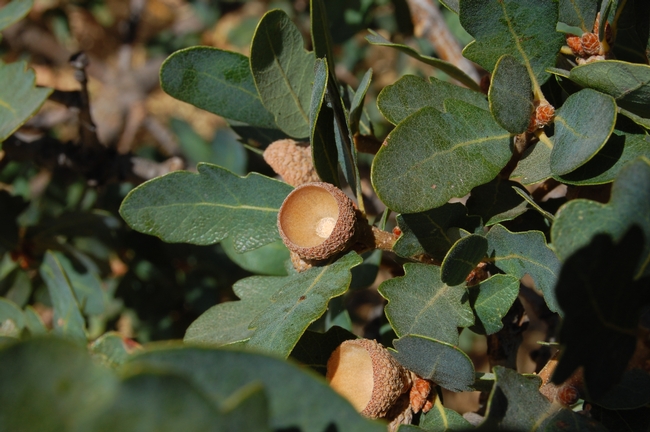
Although blue oaks can tolerate fast-burning grass fires, they have less success in surviving hotter brush fires, according to University of California Department of Agriculture and Natural Resources (UCANR). If a tree does survive a fire event, it can reproduce both through seeds and by sprouting from burnt stumps. Blue oaks can produce sprouts after a low- to moderate-severity surface fire, and younger trees have the edge on older trees for fire survival odds. On younger trees, the light-colored bark (hence “white oak”) is thick and helps reduce fire damage, the USDA notes, whereas the bark of mature blue oaks is thin and will flake off as the trees age, making older blue oaks less insulated against fire. After a fire, blue oaks can also re-establish from acorns that have dropped from surviving parent trees and/or been dispersed by animals, among other possibilities.
USDA research also reveals that the blue oak's post-fire recovery is likely aided by the fact that it withstands extreme drought by dropping leaves under water stress and producing a flush of new leaves when wet weather returns. In fact, in wet years, crown-scorched blue oaks may produce a flush of new leaves soon after fire.
Native American Uses:
All parts of the blue oak were woven deeply into the culture and survival of California's native peoples. It was one of more than a dozen oak species whose acorns contributed a major source of dietary nutrients and calories. Because of their superior flavor, blue oak acorns were among the most commonly gathered.
A Plant Guide published by the Natural Resources Conservation Service (NRCS) provides an exhaustive list of the ways California Native Americans used blue oak wood, bark, and acorns, including as “medicine, dyes, utensils, games, toys, and construction materials.” Locally, the Maidu used oak shoots to frame cradleboards and oak posts to construct shelter, and the Yana used an oak paddle in cooking. Traps for birds were baited with acorns, and split acorns became dice for gambling.
Besides providing physical sustenance to native peoples, I imagine that the peaceful beauty of blue oak woodlands fed their souls. Twisted, dwarfed blue oak silhouettes are a classic component of the California landscape. These trees are prime examples of successful adaptation to truly demanding habitat and climate conditions.
Sources and further information:
UCANR: Oak Woodland Management: Blue Oak
NRCS:BLUE OAK: Quercus douglasii Hook. & Arn.
Rising From the Ashes
Master Gardeners are taking note of the vegetation emerging on property destroyed by the Camp Fire. On Fay Crociani's Upper Paradise lot, native salvia reappeared in early January, sprouting from roots of plants that had burned to the ground. A potted erodium (Alpine geranium) also showed leaves in January, followed in February by green leaves emerging from desiccated black iris rhizomes. More irises, planted in plastic pots, survived the fire even though the plastic melted around them, and other plants and leaves continue to rise from the scorched ground. Fay encourages folks to watch and see what comes up before totally digging up an area. She says “there is real magic and joy in my heart when I spot new growth. I know hundreds of plants will never come back, but many, many will if we have the patience to wait.”
By Laura Lukes, UC Master Gardener of Butte County, February 8, 2019
It didn't take long. Soon after the first post-Camp Fire rains, there was green in the burned area. Along lower Skyway, a blanket of soft verdure overlay the harsh scars of incineration. While the people of Paradise rebuild and replant in the developed areas, what will grow back in the foothill grasslands and the forested areas?
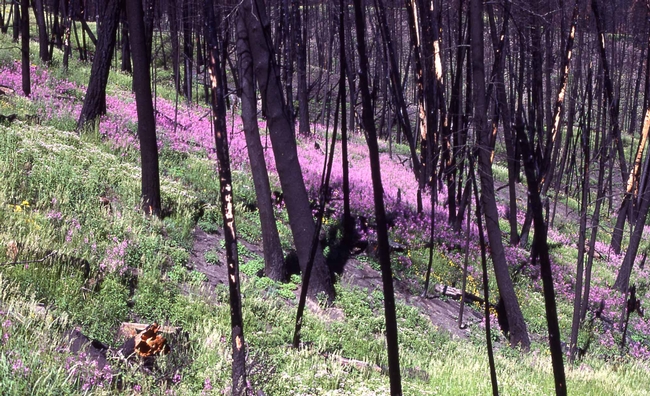
Farther up the shoulder of the Sierra Nevada, starting at about 3,000 feet, the ecosystem shifts to the lower montane forest zone. Tree species thriving in this zone are a diverse mix of ponderosa pine, California black oak, sugar pine, incense cedar, and white fir.
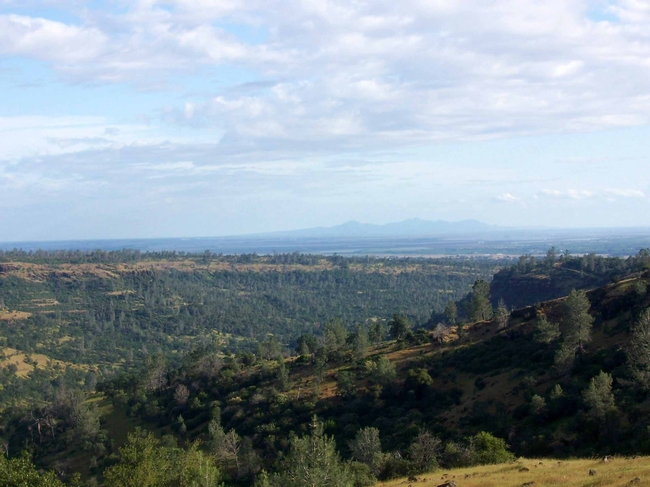
- Fire-stimulated germination (ceanothus, manzanita)
- Adventitious or latent axillary buds, dormant until the next growing season or remaining latent for years (oaks, ceanothus)
- Lignotubers - rounded woody growth at or below ground level on some shrubs and trees that grow in areas subject to fire or drought, containing a mass of buds and food reserves (manzanita, chamise)
- Fire resistant bark (ponderosa pine, Douglas fir, cedar)
- Serotinous cones (seeds release in response to an environmental trigger such as fire) and fire-stimulated seed release (several pine species)
Plant recolonization after a fire or other major disturbance is known as secondary succession. In general, and broadly speaking, first the “pioneer species” appear, and the landscape is dominated by small flowering herbaceous plants which die back with the summer dry period. So the usual suspects that bloom each spring and early summer in our area, like lupine, poppy, and monkeyflower, should be back. We may also see the spectacular fireweed (Chamerion angustifolium, also classified as Epilobium angustifolium), often one of the first colonizers of the soil following a fire. After the 2016 Lake County fires, fireweed's beautiful magenta blooms dotted the hillsides along State Route 20.
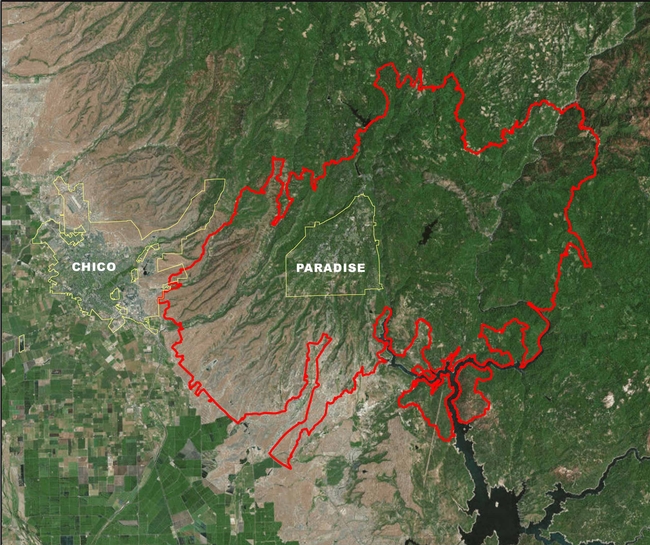
Appearing next in post fire plant succession are the woody shrubs whose seeds and/or lignotubers survived beneath the burned soils. We can expect to see manzanita, ceanothus, and blue oak seedlings, and perhaps sprouts from the few bushes that weren't completely incinerated. The buckeye may come back, along with some of the other oak species listed above.
In the archetypal secondary succession schematic for these ecosystems, pines appear next on the landscape timeline. But a recent study conducted jointly by UC Davis and the US Forest Service surveyed more than a dozen burn sites in California and found that over 40% of pine tree forests did not successfully regenerate after a large, hot fire. Pine trees survive better after moderate, slow burning fires that kill the understory but do less damage to taller trees. In addition, high intensity burns can kill most trees in an area, so there may not be any left to drop seeds to start a new stand. Pines that do sprout have to compete with the shrubs that have developed post-fire survival strategies.
As noted in the Sierra Nevada Ecosystem Project, 1996 report, “plant responses to fire vary and are often determined by a complex interaction among external factors such as temperature, soil moisture, and heat duration…and season of burn.”
What's different now? What's the overriding “external factor” in this case? It's the sheer intensity of this latest round of Northern California fires, and the attendant, albeit temporary, damage to the soils. Only time will tell which blend of survivors will return to create the green in the Camp Fire burn.
Aerial Footprint of the Camp Fire
Source: Esri, DigitalGlobe, GeoEye, Earthstar Geographics, CNES/Airbus DS, USDA, USGS, AEX, Getmapping, Aerogrid, IGN, IGP, swisstopo, and the GIS User Community
By Brent McGhie, UC Master Gardener of Butte County, January 11, 2019
Fire is a normal part of the natural environment in California, so if you live in the wildland-urban interface (WUI), it's not so much a question of if, but of when your home will be exposed to wildfire. With this thought and the devastation of the Camp Fire fresh in mind, many Butte County property owners may be thinking about creating a fire-resistant landscape around their homes. Not only is this a prudent course of action, a 2005 revision of the California Public Resources Code (PRC 4291) requires that property owners create 100 feet (or to the property line) of defensible space around homes and buildings. Defensible space is defined as the area around a structure where the landscape is designed and maintained to decrease fire danger. Creating defensible space also gives firefighters an opportunity to safely protect your home.
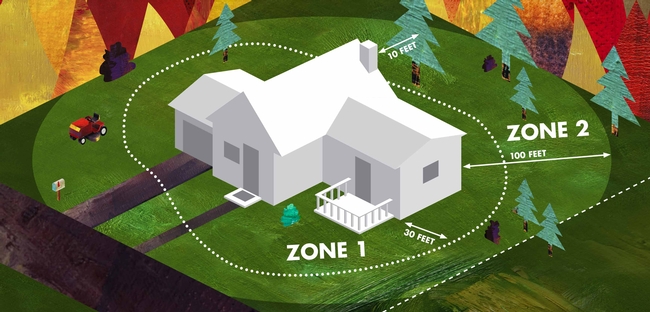
If a fire reaches the crown of a tree, its heat intensity increases and this can increase the combustibility of surrounding vegetation. Low tree branches create fuel ladders that allow fires to climb into a tree. To prevent fires from ‘crowning,' these ladder fuels must be eliminated. Cal Fire recommends that the lower branches of a mature tree should be pruned to create a clearance of three times the height of the shrubs beneath it. For example if a shrub is four feet tall, the tree should be pruned so that there is 12 feet of clearance between the top of the shrub and the lowest branches of the tree. For younger trees, the lower one-third of branches should be removed.
The area that is 30 feet closest to a home is often called the “home defense zone” or, as Cal Fire puts it, the “Lean, Clean and Green Zone.” In this area, highly flammable fuels should be eliminated or minimized and widely spaced plants should be kept green and well irrigated. Vegetation in this zone should be comprised of shorter plants such as grasses and non-woody flowers. If shrubs or trees are planted, they should be fire-resistant plants such as deciduous trees (which shed their leaves in the fall) or non-woody natives and other perennials such as salvias. Fire-resistant ground covers are also an acceptable choice for this area. Avoid planting broadleaf evergreens (like holly and coyote bush), conifers (like pines, junipers, cedars, and firs) and palms, because they are highly flammable.
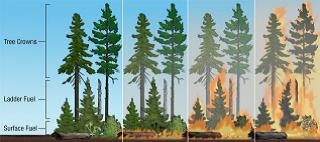
When planning a firewise landscape, the contribution of hardscape features should not be overlooked. Decomposed granite, cement, asphalt or gravel pathways and driveways make effective firebreaks. Structures such as patios and masonry walls and water features like pools, ponds, and streams will also impede the advance of a fire.
Before moving beyond the 30-foot home defense zone, mention should be made of items that do not belong too close to a home. Most propane tanks should be located a minimum of 10 feet from any structure, and woodpiles should be at least 30 feet away. A cord of seasoned firewood contains the energy equivalent of approximately 174 gallons of gasoline! Would you store that much gasoline on your porch? Also, flammable liquids such as gasoline, paint thinner and turpentine should be properly stored away from ignition sources and combustibles.
The outer 70 feet of the defensible space is called the “reduced fuel zone.” As with the home defense zone, plants in this zone should be well spaced horizontally and separated vertically to eliminate fire ladders. Fire resistant plants should also be used here. Most surface litter such as leaves, pine needles, and twigs should be removed so that this layer is no more than three inches deep. Dead annual grasses should be mowed to a height of no more than four inches. Mature trees without shrubs growing beneath them should be limbed to a height of six feet above the ground. All plants should receive adequate water and dead branches in trees and shrubs should be regularly removed. As noted in the UC Cooperative Extension's fact sheet on defensible space, “The goal of brush clearance is not to remove all vegetation. When done well, cleared areas should still include enough well-spaced and judiciously pruned plants to protect against excessive erosion and provide wildlife habitat.”
If organic mulches are used in the reduced-fuel zone, a 2008 study showed that a mulch of composted wood chips spread two to three inches deep showed the slowest fire-spread rate of the eight mulches tested. A potential disadvantage of wood chip mulches is that they tend to smolder and can be difficult to extinguish. In general, fine, stringy mulches such as shredded bark burn more rapidly than larger chunks.
Establishing defensible space can be summarized by the following three R's: 1) Remove dead and dying plant material; 2) Reduce the density of vegetation and ladder fuels; 3) Replace hazardous vegetation with less flammable, well-irrigated fire resistant plants.
Further information on fire safety for homeowners can be found in two highly recommended Cal Fire publications: “Homeowners Checklist – How to Make Your Home Fire Safe” and “Why 100 Feet?” And for property owners who are considering landscaping from scratch, the Sonoma-Marin Saving Water Partnership has developed eight fire-rebuild landscape design plans that are well worth considering.
For more information on creating fire resistant landscapes, see the Fire-Safe Landscape section of the UC Master Gardeners of Butte County website. For other topics of interest to local gardeners please visit our home page. And if you have a gardening question or problem, call the Master Gardener Hotline at (530) 538-7201.
By Laura Lukes, UC Master Gardener of Butte County, December 14, 2018
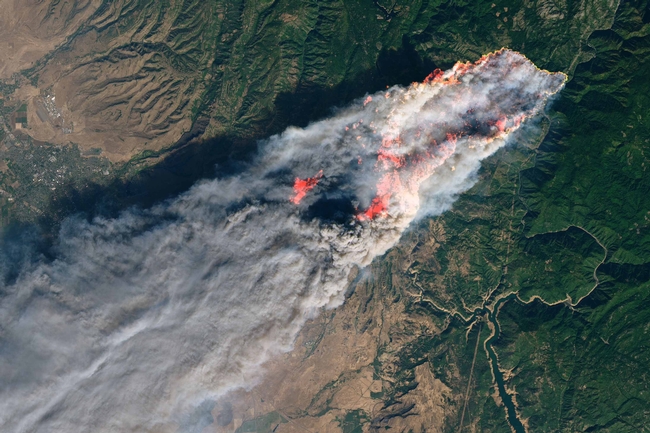
The chemistry of soil hydrophobia is fairly basic. Plant materials that burn hot release a waxy substance that penetrates the soil while still in gas form. It takes very high temperatures to produce this gas which coats soil particles when it cools and becomes solid. To the naked eye, hydrophobic soils look like their non-hydrophobic counterparts. But biologically speaking, they have now become latent disaster zones.

Runoff caused by rainfall on water-shedding soils can also cause the loss of fertile topsoil. And it can clog water conveyance facilities including manmade culverts, gutters, and ditches, as well as streams and rivers. The upside of rainfall on soil hydrophobicity is that, generally speaking, water repellency weakens with each rain event.
The type of soil and the intensity of the fire determine how deeply hydrophobia penetrates the soil, and how long the condition persists. Paradoxically, the fastest draining soils, (light, sandy soils with large pores) are the most prone to post fire hydrophobicity because they transmit the heat more easily than heavy, dense, clay soils. Soil types within the approximately 240 square miles burned by the Camp Fire vary from the sandy loam found in parts of Butte Creek Canyon to the red, rocky soils of the ridge communities. In general, the bulk of the burned area is perched atop the Tuscan formation. In its Soil Survey of Butte Area, California, Parts of Butte and Plumas Counties, the Natural Resources Conservation Service (NRCS) notes that these ridges “consist mainly of mudflow breccia, volcanic sandstone, and volcanic conglomerate.” The soils sitting on these thick layers of volcanic bedrock tend to be naturally clayey and slow draining.
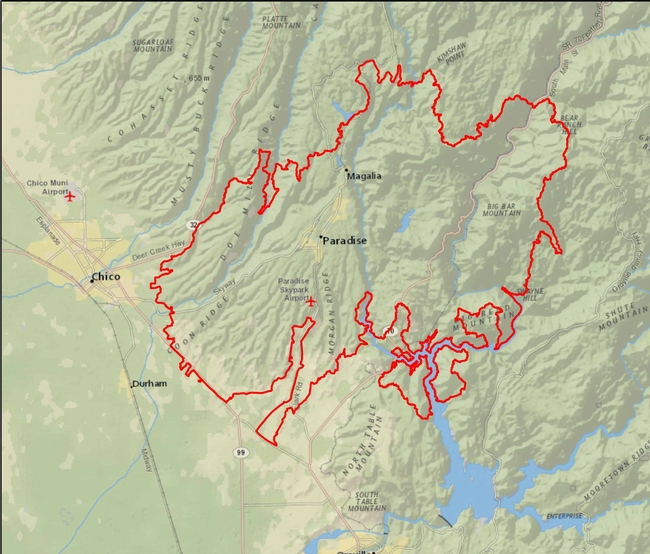
Prescriptions for large scale mitigation within the burnt forested public lands, and the large acreages of undeveloped private landholdings, are outside of the scope of this article. For the private landowner, the following steps outlined by Douglas Kent in his Press Democrat article can be taken to lessen and control the damage caused by the treacherous combination of heavy rain and burn-scarred soils. These procedures can be followed if the homeowner is 1) allowed back onto his / her property and 2) able to stay long enough to put these measures in place.
To hold your ground:
- Clear drainage systems such as culverts, diversion ditches, or narrow swales, of debris. Clogged drains are a primary cause of erosion, even without fire damage.
- Divert water from areas originally designed to sheet runoff to the landscape: instead, redirect the runoff towards your newly cleared drainage systems or, if they exist, towards storm drain systems such as gutters. Use sandbags, diversion ditches, boards stacked on top of one another and staked in place, dry stacked walls, or bales to redirect water flow.
- Minimize foot and equipment traffic on burned landscapes. Such traffic can further compact already damaged soils on flat areas, and can weaken soil bonds and dislodge soil particles on slopes. Develop plans to restore your injured landscape before tramping on it, and keep all traffic to the bare minimum during restoration activities.
- Leave non-toxic debris in place wherever possible. Burnt plant remnants and other garden features can protect the landscape from wind and water erosion, and help protect any seeds and plants that survived the fire.
You may not want (or be able) to return to your property within the perimeter of the Camp Fire. On behalf of the Butte County Master Gardener Program, we hope this information will help you in the process of healing the scars on your land and those in your soul. If you don't, we hope you find peace and beauty wherever you choose to land and to landscape.
For more information on dealing with the effects of wildfire on soil, and landscaping with the possibility of fire in mind, see the Fire-Safe Landscape section of the UC Master Gardeners of Butte County website. Among other resources, see “The New Normal: Rebuilding Soil After Fire,” a PowerPoint presentation from the UC Master Gardeners of Sonoma County which covers how wildfires affect soil, soil regeneration, and strategies for dealing with toxic soil.
Photo Credits:
Camp Fire Burns on the Ridge
Source: NASA/MSFC, USGS
Area Affected by Camp Fire, Aerial View
Source: Esri, DigitalGlobe, GeoEye, Earthstar Geographics, CNES/Airbus DS, USDA, USGS, AEX, Getmapping, Aerogrid, IGN, IGP, swisstopo, and the GIS User Community
Area Affected by Camp Fire, Relief View
Sources: National Geographic, Esri, DeLorme, HERE, UNEP-WCMC, USGS, NASA, ESA, METI, NRCAN, GEBCO, NOAA, increment P Corp.


